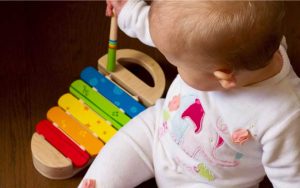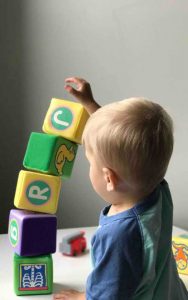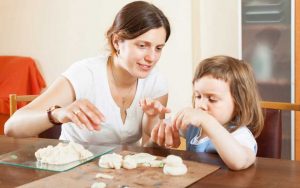No one can complain that our generation is lacking good toys for babies and toddlers these days. There are so many choices available that it can be a tad daunting to figure out which to buy (and when). While toys have always been a big part of childhood, the type of toys offered to young children matters greatly, especially if they are part of a child’s developmental journey.
The role of toys has gone through a whole lot of changes with each passing decade. They’re no longer just to keep little one distracted while mom and dad are busy, but today, they are looked upon as objects that help to spark off creative thinking or even as learning tools.
When we take into consideration how much time our children spend with their toys, it inevitably becomes much more important for us to make conscious choices about what we give to them to play with.
Best choices in baby toys
What does a baby do most of the time? Gaze at their surroundings, that’s what! That’s why toys for babies should aim to capture their attention more than anything else. for really, anything else in a baby’s toy would be a waste for now. As the weeks pass, they’ll also start to appreciate and favor certain sounds, such as lullabies, nursery rhymes, etc. So, watch what you’re paying for when you’re out shopping for baby toys!
Here are some examples of good toy choices for babies:
- Rattles! Try wrist or ankle rattles that make some noise whenever the baby moves those limbs about.
- Toy mirrors for them to look into and amuse themselves with.
- As a baby grows a little older, large rings, squeeze toys, teething toys, soft dolls, textured balls, and vinyl and board books can start to come into the picture.
- Books with nursery rhymes and poems which they can listen to and of course, which you can entertain themselves with.
Does age appropriateness matter?
Well, think about it: Apart from the obvious safety concern when it comes to small parts being swallowed, or toys that pose a strangulation hazard, etc, babies and young toddlers, for instance, may not even know how to play with certain toys where else as they grow older, they gain more skills and ability to make the most of their toys.
When babies start to get mobile
Babies between 7 months to a year old seem to never tire of trying to move around, whether it’s rolling over, pulling themselves up, standing, and cruising. To top it off, they have a very short attention span! Most babies this age enjoy trying to find hidden objects and putting things in and out of containers.
Good toys for older babies (7 months to 11 months):
- Anything that they can pile up, stack or take in and out such as non-toxic plastic bowls, large beads, balls, and nesting toys
- Things to build with — large soft blocks and wooden cubes
- Toys to practice throw and catch with such as oversized balls
- Push and pull toys
- Tunnels to crawl into
- When in the mood for some pretend play, they will enjoy playing with puppets, dolls, plastic and wood vehicles with wheels, etc.
Playtime for 1-year-old
Other than when they’re watching their favourite show on television, most one-year-old can hardly ever stay put long enough to pay attention to anything — and as they can understand more than you think, they generally enjoy well-narrated stories, hence the undivided attention! They also play next to (but not necessarily with!) other children and some show a tendency to possessiveness when it comes to toys. They also love exploring when they’re feeling comfortable.
Here are some good toy choices for one-year-old:
- Things to pretend with — toy phones, dolls (with dollhouses), baby carriages and strollers, dress-up accessories (scarves, purses), puppets, stuffed toys, plastic animals, etc.
- Recordings with songs, rhymes, simple stories, and pictures
- Things to create with — wide non-toxic, washable markers, crayons, and large paper
- Things to build with — cardboard and wood blocks
- Board books with simple illustrations or photographs of real objects
- Large pegboards, puzzles, toys with parts such as dials, switches, knobs, lids, etc.

Toddlers love to test their physical capabilities by jumping from heights, climbing, hanging by their arms, rolling, and rough-and-tumble play. As they gain better control of their hands and fingers, they tend to go for activities that involve small objects such as prying at toy parts, fitting pieces of puzzles together, etc. They also enjoy playing (and looking) at colorful objects and may enjoy being read to using well-illustrated picture books.
Here are some ideas for a toddler’s playtime:
- Safe wood puzzles (with 4 to 12 pieces)
- Blocks that snap together
- Objects to sort (by size, shape, color, smell), and things with hooks to hone their building skills
- Picture books with colourful, intricate details
- CD and DVD players with a variety of music
- Large and small balls for kicking and throwing
- Ride-on toys
- Tunnels, low climbers with soft material underneath
- Pounding and hammering toys
The Waldorf Approach
For parents who are not familiar with this term, the Waldorf approach for early childhood education is based on sensory experiences and investigations rather than fancy toys that cost a bomb. This approach allows for lots of guided free-play, with an emphasis on a home-like atmosphere filled with natural materials. If you were to select toys using the Waldorf approach, you’ll be looking for:
- Good quality, durability
- ‘Playability’
- Anything healthy for humans and the planet
- Natural materials that feel good to all our senses — including visually beautiful toys, toys that feel good to hold
- Toys that can be put away quickly
- Non-competitive, social toys
- Toys that are toys — where ‘learning’ is not forced

Children need free, undirected play for creative growth, self-reflection, and decompression. Play is a “happy talent” and open-ended play helps foster happy talent in a relaxed way.
It’s important to allow your children to discover the role and objectives of toys themselves. Why show them what they ‘should’ do with a toy when they can have so much fun doing whatever they want to? If parents could just let go of their expectations when it comes to playing, they will be rewarded by a peek into a child’s wonderful imagination and potential.
With no expectations from parents and no predetermined outcome, the open-ended play does away with the pressure of having to accomplish or achieve something out of playing. It allows children to focus on creating based on inner inspiration. During play, children have choices and decisions to make. This format offers great potential for self-discovery.
The wonders of mistakes in playtime
Since trial and error is part of open-ended play, unintended mistakes cause children to pause and wonder. “Errors” produce fascination and foster new creation and when left to their own devices, self-initiating behaviors are developed.
What are open-ended toys?

Examples of good open-ended toys are:
- Balls of all sizes
- Sticks (check for sharp sides, thorns, etc)
- Various boxes including empty cereal boxes
- A rope/piece of string (under strict supervision)
- Toilet paper tubes
- A spade, a bucket, and some sand/dirt/snow
- Simple toy blocks
- Large, colorful/printed pieces of fabric
- Dolls and figurines
- Plastic jars or containers with lids
Have you ever noticed?
Have you ever noticed that the more expensive the toy, the more specific its functions are? These kinds of toys tend to promote or advocate a clear, ‘right’ way of playing with them. These are the kind of toys that we term as ‘closed end toys’ and may come with a manual even, directing parents on the correct way to play with them! Gender-specific toys also fall smack into this category for they restrict imaginative play for little boys and girls and direct them away from avenues of empathy and understanding of the opposite gender.
Toys you can do without
It’s tough being a parent, for one hand you know you want to give your child the best when it comes to toys to play with, and on the other hand, you may be unwittingly falling short either in the choices you make or in which toys can stay and which need to go! Here, we list down the latter to make it easier for you. Throw it out if it’s:
- Broken
- Have missing pieces
- Is developmentally inappropriate or lax
- Is ‘fixed’ in concept, which means it leaves little or nothing to your child’s imagination
- It requires you to buy more of to make it work/keep it working
- It also comes with social pressure to you buy more/ collect
- It’s too complicated to play with
- It’s not robust enough for a young child and/or it breaks easily
- You find it annoying or offensive
- It encourages violence (evil characters/war games)
Could you be choosing looks over function?
It’s understandable that as parents, you’d want some value for your money when it comes to toys. It should look good and attractive enough to match its price tag! At times like these, take a closer look at the toy and determine if your child can benefit from it or not.
Foster better development with modern toys
Toys can be a wonderful part of a child’s development. Not only do toys help promote physical activities, but they can play a big role in helping little ones learn about sharing, taking turns, getting creative, etc.
At some point, your baby will start to talk. Many adults struggle with communication, so you are doing your child a massive favour by helping them build on this skill as early as possible. Social skills are one of the first steps to your baby’s development, and they can start early with games that involve sharing or taking turns. This could be with passing a ball or building blocks together. Fortunately for us today, there are modern toys that are interactive, that speak or ask them to speak, and that address emotions and feelings can help them grow. As your baby grows into a child then games board games that involve multiple players and interaction can be a great way to teach them more advanced social skills.
Once your baby has grown out of some of their basic toys you can start teaching them things like shapes and colours, as well as helping them practice their motor skills. These skills can help your child grow into happy, healthy, and active adults. From throwing balls around to riding on a tricycle — help your toddler to build good motor skills can give him or her much-needed confidence in their physical ability as they grow older and attend a playschool, kindergarten, etc.


